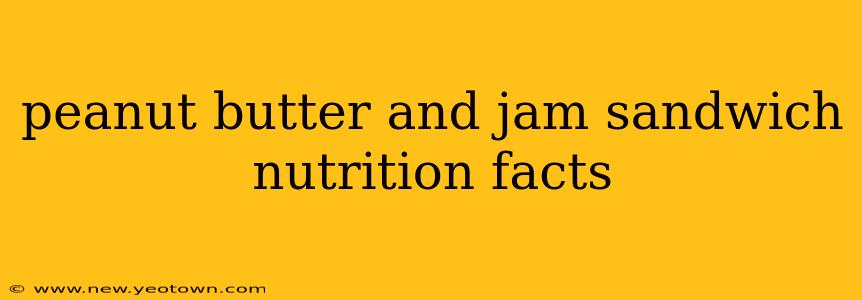The classic peanut butter and jelly sandwich. A childhood staple, a lunchtime favorite, a quick and easy snack. But have you ever stopped to consider just what's in this seemingly simple combination? It's more than just a delicious taste; it's a surprisingly balanced source of nutrients, depending on your ingredients, of course! Let's unpack the nutritional facts, exploring the good, the bad, and the surprisingly delicious aspects of this beloved sandwich.
My name is Alex, and I've spent years researching the nutritional value of everyday foods. My passion is helping people make informed choices about their diet, and today, we’re exploring the often-overlooked nutritional profile of the peanut butter and jelly sandwich.
What are the typical nutritional contents of a peanut butter and jelly sandwich?
This largely depends on the specific brands and types of peanut butter and jelly you use. A standard sandwich made with two slices of white bread, two tablespoons of peanut butter, and two tablespoons of grape jelly will offer a mix of carbohydrates, fats, and protein. The exact macronutrient breakdown varies, but you're typically looking at around 300-400 calories, with a significant portion coming from carbohydrates and fats. Protein content is moderate, offering a decent amount of satiety. Vitamins and minerals will also be present, but the levels vary depending on the ingredients. We'll delve into specifics below.
What are the health benefits of eating a peanut butter and jelly sandwich?
While not a health food in the strictest sense, a peanut butter and jelly sandwich can offer some nutritional benefits. Peanut butter is a good source of protein and healthy fats, notably monounsaturated fats, which are beneficial for heart health. It also provides fiber, contributing to healthy digestion. The jelly, while typically high in sugar, can contribute some vitamins and antioxidants, depending on the fruit used. For example, grape jelly offers some antioxidants, although the added sugar needs to be considered.
Choosing whole-wheat bread instead of white bread significantly boosts the fiber content and adds additional nutrients. Opting for natural peanut butter without added sugar or hydrogenated oils further improves the nutritional profile.
How many calories are in a peanut butter and jelly sandwich?
As mentioned earlier, a typical peanut butter and jelly sandwich contains approximately 300-400 calories. This number can fluctuate significantly based on several factors:
- Type of bread: Whole-wheat bread will generally have more calories than white bread due to its higher fiber content.
- Peanut butter type: Natural peanut butter (just peanuts and maybe salt) tends to be lower in calories than varieties with added sugar or oils.
- Jelly type: Different jellies have varying sugar contents, impacting the overall calorie count. Fruit spreads with added sugars will have more calories.
- Serving size: Using more or less peanut butter and jelly will directly affect the calorie count.
It's always best to check the nutritional information on the specific products you're using to get the most accurate calorie count.
What are the disadvantages of eating peanut butter and jelly sandwiches?
While enjoyable and reasonably nutritious when made with better ingredients, the peanut butter and jelly sandwich does have drawbacks:
- High sugar content: Most jellies are high in added sugars, contributing to potential health issues related to excessive sugar intake, like weight gain, increased risk of type 2 diabetes, and heart disease.
- Sodium content: Depending on the bread and peanut butter, the sandwich can be relatively high in sodium, impacting blood pressure for some individuals.
- Refined carbohydrates (if using white bread): White bread provides minimal nutritional value besides carbohydrates. It lacks fiber and essential nutrients, leading to energy crashes and less satiety.
- Allergies: Peanut allergies are quite common, and it’s crucial to be mindful of this potential allergen.
Is a peanut butter and jelly sandwich a healthy snack?
The healthfulness of a peanut butter and jelly sandwich depends entirely on the ingredients used. A sandwich made with whole-wheat bread, natural peanut butter (without added sugar or hydrogenated oils), and a lower-sugar fruit spread is a much healthier option than one made with white bread, sugary peanut butter, and high-fructose corn syrup-laden jelly.
Making conscious ingredient choices turns this classic sandwich into a more balanced and nutritious meal or snack. Prioritize whole grains, natural peanut butter, and lower-sugar options to maximize its nutritional benefits. Remember, moderation is key!

